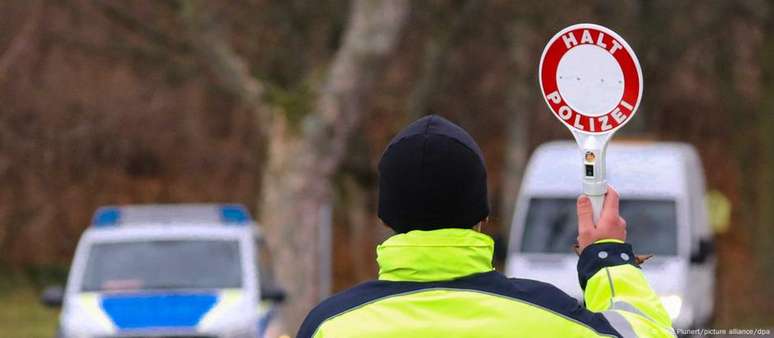To justify its decision, the German government claims that the refugee reception system is overloaded. Poland and Greece criticize controls within the Schengen area This Monday (16/09) Germany expanded controls at its land borders, a decision that was promptly criticized by other European countries, such as Poland and Greece.
From Monday, the German Federal Police will check travel documents not only at the eastern and southern borders, but also at the northern and western borders. The measure, which reaches the limits with Denmark, the Netherlands, Belgium, Luxembourg and France, is in addition to what is already in place at the borders with Poland, the Czech Republic, Austria and Switzerland.
The new checks are initially limited to six months, i.e. until March 15, 2025, and can be extended up to two years in justified cases. Since Germany is located in the center of the Schengen area, additional checks could cause disruptions in the movement of people and goods.
Polish Prime Minister Donald Tusk said that Germany was putting the entire Schengen area at risk with its expanded controls.
Georgian Prime Minister Kyriakos Mitsotakis said that the answer to irregular migration cannot be the unilateral abolition of the Schengen Treaty and that the transfer of the problem to other signatory countries “cannot be tolerated”.
“Last case” measure.
Travelling within the Schengen area, which covers 29 countries (25 EU countries plus Iceland, Liechtenstein, Norway and Switzerland) is possible without passport control and without queues. Only at external borders and airports is it necessary to present a passport.
Internal border controls are only foreseen under certain conditions. However, it is the Member States who decide whether these conditions have been met and then notify the adoption of the controls only to the European Commission in Brussels.
The EU executive could only issue a warning to member states about border controls, but it never did. In the case in question, the Commission only reaffirmed that border controls should be an exception and a “last resort” measure. Furthermore, the controls should be set up temporarily, for a maximum of three years.
German Interior Minister Nancy Faeser of the Social Democratic Party (SPD) justified the decision by the high number of unauthorized immigrants entering the country and an overburdened refugee reception system.
The Berlin government also believes new measures are needed to “protect internal security from the ongoing threats of Islamic terrorism and cross-border crime” following the deadly knife attack in Solingen, claimed by the extremist group Islamic State.
Hundreds of exceptions
Germany is not alone in expanding border controls. Eight other Schengen countries have already set up checkpoints at internal borders. Since 2006, 441 control measures have been reported in the Schengen states, most of them in France.
After the terrorist attacks of 2015 and 2016, the government in Paris reserved the right to permanently control all its land borders. Controls are repeatedly extended, with various justifications, including terrorist threats, migratory pressure, Russian espionage or major sporting events.
Since 2015, Germany has also controlled its border with Austria, on the grounds of reducing the number of asylum seekers entering the country and the risk of terrorism. Austria, in turn, controls its borders with Slovakia, the Czech Republic, Hungary and Slovenia under the same justifications.
The controls reached their peak during the Covid-19 pandemic four years ago, when almost all Central European countries tried to combat the spread of the virus through passport checks and partial border closures, which led to traffic congestion and numerous complaints from travellers and truck drivers.
How it is in practice
The question remains how to implement such a comprehensive measure in practice. The police officer of the German parliament, Uli Grötsch (SPD), described the additional border controls as a major challenge, stressing that 1,200 kilometers would be added to the 2,400 already checked. He emphasized that more police officers were urgently needed for this purpose.
The Police Union (Pil) also expressed doubts about the feasibility of additional checks due to staff shortages. The forces are already overstretched and an additional 5,000 police officers are needed to carry out the new control tasks, said one of the union’s directors. The Federal Police Command rejects the criticism and maintains that there are sufficient forces available to implement the new checks.
According to the Bavarian government, border controls with Austria, which already exist, are specific and based on visual checks. This means that not everyone has their documents checked. Only vehicles that appear suspicious are intercepted. Checks on motorways are also possible, but not in a general and continuous manner.
Luxembourg’s Interior Minister Leon Gloden told DW that Faeser assured him that the checks would affect car traffic and daily life as little as possible and that they would not be carried out on bridges leading to Luxembourg.
The Dublin Rules
With the checks, the federal government wants to identify people who try to enter Germany “without authorization.” Only those who do not apply for refugee status upon arrival at the border will be promptly denied entry.
If an asylum application is submitted at the border, the German authorities must check whether they are responsible for examining it or whether the applicant has already submitted or could have submitted a similar application in another EU country.
The applicant may then be sent back to the country where he or she first applied for asylum or through which he or she entered the Schengen area, if that country agrees.
This procedure, which is provided for by the so-called Dublin rules of the Schengen Agreement, can take months. For this reason, German Minister Faeser is calling for consultations with the EU asylum databases and negotiations with other Schengen countries to be accelerated.
Until the responsibility for processing applications is clarified, asylum seekers will have to be housed near the German border and even detained if there is a risk of absconding. These detention camps will still have to be built by the German states.
The Austrian government has stressed its position on the matter in statements to the German press. “Austria will not accept anyone sent back from Germany. There is no room for maneuver,” Interior Minister Gerhard Karner told the Bild and Frankfurter Allgemeine Zeitung newspapers. He acknowledged that Germany has the right to send people back if another EU country is responsible for their asylum claim. However, he said that this requires a formal procedure and the consent of the country in question.
Hungarian government irony
According to the German Federal Police, 34,000 people attempted to enter the country without authorization between January and July 2024. 17,000 were denied entry directly at the border. The other half were admitted and their cases are being handled according to the Dublin rules.
Last year, the federal police arrested 127,000 people at the border who were trying to enter Germany without authorization. A quarter were refused entry directly at the border. There are no figures on the actual number of attempted entries into the country or how many more people could have been detained if there had already been more border controls.
Hungary, which holds the rotating presidency of the EU Council, has been somewhat mischievous about the measures announced by the German government. The Hungarian government has been criticized for years for its tough stance against illegal immigration. “Now it seems that those who have always rejected our approach are adopting it too. It is strange how a few years and a migration crisis can change opinions,” the right-wing populist government in Budapest said in a press release.
Source: Terra
Rose James is a Gossipify movie and series reviewer known for her in-depth analysis and unique perspective on the latest releases. With a background in film studies, she provides engaging and informative reviews, and keeps readers up to date with industry trends and emerging talents.


![Such a great sun in advance [SPOILERS] Such a great sun in advance [SPOILERS]](https://fr.web.img4.acsta.net/img/99/97/9997e78333cbdcb211d89de0cedb2d22.jpg)




